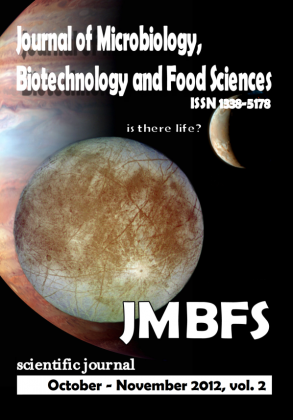EFFECT OF THE ADDITION OF COMMON BEAN FLOUR ON THE COOKING QUALITY AND ANTIOXIDANT CHARACTERISTICS OF SPAGHETTI
Keywords:
Antioxidant; Common beans; Cooking; Polyphenols; SpaghettiAbstract
Pasta is a nutritionally unbalanced food, due to its low fat and fiber and low value of its protein. It is considered an adequate vehicle for food supplementation with minerals, proteins and other healthy components such as bioactive compounds present in common beans. The effect of composite pasta (wheat – common bean; 30 % w/w) on the cooking quality (optimal cooking time, cooking loss, weight loss, firmness, color), total phenolic content, antioxidant capacity by DPPH and ORAC assays and phenolic acid profile was investigated. According to the quality parameters, pasta added with bean flour was less hard with respect to the pasta made from durum wheat. The total phenolic content and antioxidant capacity by DPPH and ORAC assays were higher in the pasta with common bean flour than in the pasta control. Also, more phenolic acids were identified in cooked pasta containing common bean flour as analyzed by HPLC.Downloads
Download data is not yet available.
Downloads
Published
2012-10-01
How to Cite
Alberto, J., Francisco, R., Rocha-Guzmán, Elizabeth, N., Reynoso-Camacho, RosalÃÂa, Yao, Fang, R., Manthey, Frank, Chang, Sam, Rivas, G., Marisol, Gallegos-Infante, & González-Laredo. (2012). EFFECT OF THE ADDITION OF COMMON BEAN FLOUR ON THE COOKING QUALITY AND ANTIOXIDANT CHARACTERISTICS OF SPAGHETTI. Journal of Microbiology, Biotechnology and Food Sciences, 2(2), 730–744. Retrieved from https://office2.jmbfs.org/index.php/JMBFS/article/view/7177
Issue
Section
Food Sciences
License
Copyright (c) 2012 José Alberto, Gallegos-Infante, Marisol, GarcÃÂa Rivas, Sam, Chang, Frank, Manthey, Rong Fang, Yao, RosalÃÂa, Reynoso-Camacho, Nuria Elizabeth, Rocha-Guzmán, Rubén Francisco, González-Laredo

This work is licensed under a Creative Commons Attribution 4.0 International License.
All papers published in the Journal of Microbiology, Biotechnology and Food Sciences are published under a CC-BY licence (CC-BY 4.0). Published materials can be shared (copy and redistribute the material in any medium or format) and adapted (remix, transform, and build upon the material for any purpose, even commercially) with specifying the author(s).

